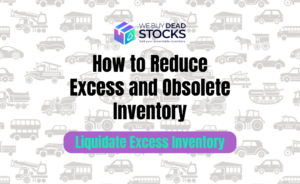To answer the question of what inventory obsolescence is, let’s begin with its definition. Obsolete stock is also called “overabundance” or “dead” stock. It is the stock that a business doesn’t completely accept that it can utilize or sell because of an absence of interest. Stock generally becomes outdated after a specific measure of time lapses. This also happens if the stock arrives at the finish of its life cycle.
Items that become out of date or dead go through different strides before they become unsellable. It generally begins as sluggish stock, then, at that point, becomes overabundance stock lastly transforms into out-of-date stock.
Outcomes of Obsolete Stock
Outdated stock likewise appears as a cost on the financial record. One of an organization’s most significant monetary reports usually appears from obsolete inventory.
Furthermore, old stock is frequently disregarded for a long time. This also means it occupies a significant room in the distribution center. Rather than utilizing this expensive land to store valuable and new items, old stock gathers residue and devalues.
Advantages of Disposing of Old Stock
Then again, disposing of out-of-date stock can help a business’ monetary well-being. It brings down general stock expenses. It can also help with the misfortunes accompanying discounts such as this stock.
For new organizations, staying away from outdated stock could be a basic step toward more edge to their businesses. Selling a scrap of obsolete stock may also generate income for the company.
Moreover, limiting out-of-date stock makes it simpler for organizations to assemble detailed budget summaries. That can ultimately get a good image of their ongoing stock conveying costs. There are fewer opportunities for accounting blunders for disregarding the overabundance of inventory sitting in a dusty corner.
5 Reasons for Abundance and Out of date Stock
Various normal issues influence stock to become old. Organizations should investigate their tasks to check whether any of these are issues. Provided that this is true, address them before they lose cash:
- Off-base Anticipating; Unfortunately, estimating is one of the greatest enemies of out-of-date stock. Be that as it may, assuming interest neglects to satisfy those hopes, the business is left with a ton of additional stock. After some time, that stock will lose its worth.
- Deficient Stock Administration Framework A stock administration framework that shows incorrect numbers. Maybe missing the mark on detailing capacities to give a thorough perspective on current stock will fuel the out-of-date stock issue.
If the stock administration framework tells a retailer it has 100 sets of jeans in a specific size, but there are 400 sets in the distribution center, for instance, it will wind up purchasing more items than it needs. Likewise, if a business can’t screen stock turns or long stretches of stock close by, it needs to approximate when it should arrange more stores.
- Bad Item Quality or Plan; At times, it’s not hard to see why items flop. Maybe a thing breaks effectively or doesn’t fill in as promoted because of either a planning oversight or a slip-up in the assembling system.
Providing a bad quality or buying a poor quality desperately impacts your business and its decisions. Clients might return these things as an issue while leaving negative surveys. As others catch wind of issues, deals fall.
Essentially, another thing that enjoys no upper hand over comparable available items could fail to meet expectations and result in an abundance of stock.
- Poor Buying; Buying should be information-driven and intently attached to determining and request arranging. At the point when it’s not, and the buying group is purchasing because of narrative information or other questionable variables, it prompts issues. Bargain-hungry buying supervisors able to buy everything in mass to decrease the expense per thing can leave an organization with many items on its hands.
- Erroneous Lead Times; Lead times make purchasers’ positions more troublesome. They need to comprehend how long after they submit a request, they will get items, which could shift among merchants. Expanded lead times, particularly if they’re surprisingly lengthy, can be particularly tricky because the interest for an item could drop in the months that pass before an association gets the products.
Conclusion
Numerous organizations squander an excessive lot of cash on old stock. While discounting modest quantities of inventory is undeniable in many cases, old stock needn’t bother to be a major supporter of liabilities on the financial record.
Finding a second home for stock waiting in the distribution center for a long time is one method for recovering the expense of overabundance stock. Performing the programming that gives point-by-point stock permeability and broad detailing can assist with forestalling the issue before it occurs by providing workers the data they need to settle on more intelligent buying and stock administration choices.
Eventually, it is easy for item-based organizations to lower old stock to support their main concerns.
The right inventory management software will help companies adopt all of these strategies. They may also cut down on obsolete inventory by tracking the movement of items in and out of the warehouse as they happen. This software alert staff when the business runs out of a specific item.





